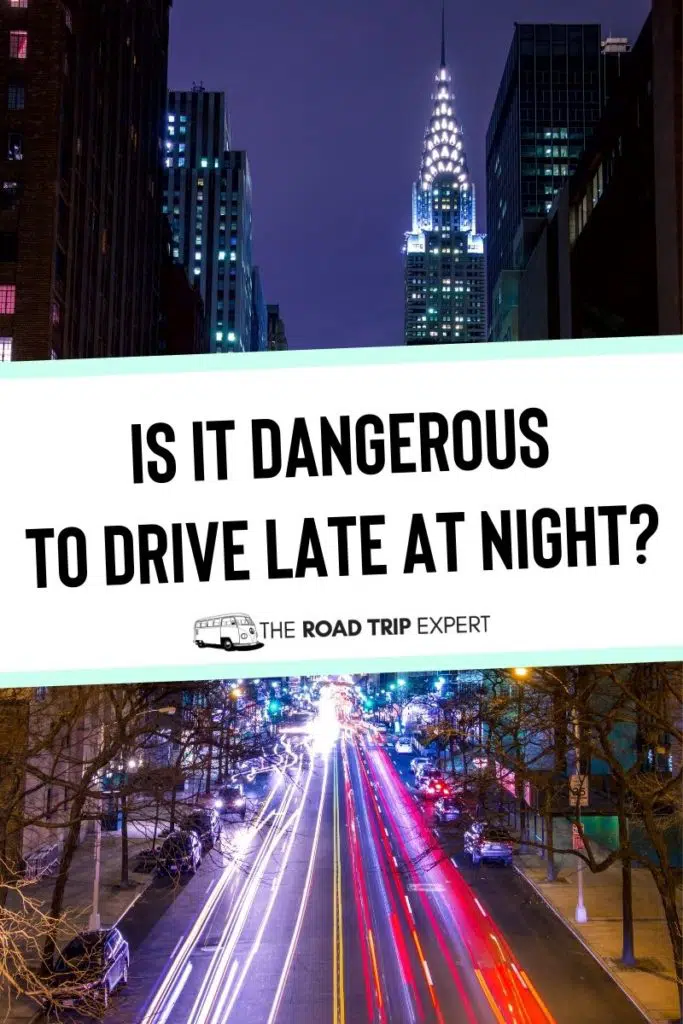Driving late at night is dangerous relative to driving during the daytime. According to the NHTSA, you’re three times more likely to be involved in a fatal vehicle accident at night. 37 percent of fatalities that occur when driving in the dark are related to speeding, therefore make sure you observe the speed limit at all times to reduce the risk of an accident.
Affiliate Disclosure: Thank you for supporting The Road Trip Expert. When you purchase through links on this site, we may earn an affiliate commission. Please see our advertising disclosure for more details.
Why is it more dangerous to drive at night?
It is more dangerous to drive at night due to the reduced light conditions which decrease visibility. This problem can be made worse by glare from bright lights. In addition, you are more likely to be fatigued which may affect your ability to respond as quickly as you would during the daytime. You’re also more likely to encounter someone driving under the influence of alcohol.
Is driving at night difficult?
Driving at night is more difficult than driving in the daytime. This is because you are more likely to experience driver fatigue which makes it more difficult to concentrate on the road. The reduced visibility caused by the dark can lead to compromised depth perception, color recognition, and peripheral vision. The potential for glare from bright lights also makes night driving challenging. With adequate preparation, you can reduce the risks associated with night driving.
When you are driving in the dark then you need to make sure your headlamps are functioning correctly. This is because you are only able to see the area that is illuminated by your headlamps plus the additional lighting. This can make it more difficult to see upcoming hazards such as wildlife, damage to the road, or other vehicles.
If the level of street lighting is poor, this can increase the difficulty of driving in the dark.
How can I make driving easier at night?
To make driving at night easier you should ensure you are properly rested and schedule frequent breaks at rest stops during your trip. Observe the speed limit at all times and drive defensively in case you encounter reckless road users. Clean your windshield regularly and use high beams when appropriate to improve visibility. Dashboard controls should be visible but ensure the lighting is not distracting.
Make sure that your vehicle has been properly serviced and maintained. You need to make sure your headlamps are operating correctly. Headlamps can lose their functionality to the point where they provide as little as 20 percent of the light generated by new ones. Misaligned headlamps can also reduce visibility during night driving, so request a check from your mechanic.
We’ve got an awesome article outlining the best tips for night driving to help you plan your journey.
Driving slower is one of the best ways to make driving easier at night. When you are traveling slower, you have more time to react to what is occurring in front of you. It’s possible that wildlife could cause a reason for you to need to react, driving slower gives you more time to do so.
If you have a long night drive ahead of you, why not grab a Free Trial of Audible Plus and listen to an audiobook? You can also follow our tips for staying awake while driving long distances.
Why does it feel like I’m driving faster at night?
The reason it feels like you are driving faster at night is due to the perceptual issues caused by the reduced visibility of objects that are further away. New objects entering your vision during night driving will be closer to the car than those observed in the daytime. Less time passes between observing a new object and passing it, creating the perception that you’re moving faster.
Is it Safe to drive long distances at night?
Driving at night isn’t ideal, but sometimes it is necessary. The NHTSA recommends avoiding driving between the hours of midnight and 6 AM or the late afternoon. If you need to drive during these hours, schedule frequent, short stops to keep yourself alert. To keep yourself safe, use your headlights so you can see and be seen. Give plenty of space to the cars in front of you and stay engaged with the road.
Items You Need For A Safe Drive At Night
- Healthy Snacks- Have plenty of healthy, easy-to-grab snacks stocked. Things like trail mix, bananas, apples, a peanut butter sandwich, veggie sticks, or some beef jerky keep you feeling energized without weighing you down.
- Water- Water is better than soda or sports drinks as it keeps you hydrated and energized but isn’t loaded with sugar.
- Lumbar Support- Sitting up straight is a great way to stay alert on a late-night drive. We recommend the Everlasting Lumbar Support Pillow. This memory foam cushion is designed to relieve sciatica, lower, middle, and upper back pain and comes with a lifetime replacement policy.
- Neck Pillow- Keep your head up and your back/neck muscles relaxed with a neck pillow. You can pick them up for cheap pretty much anywhere these days.
- Car Phone Mount- Keeping your phone mounted allows you to use it without taking your attention off the road. Try the VICSEED Universal Cell Phone Holder; we like it because it fits on your dash, windshield, or air vent and is super durable.
- Thermos- Keep a thermos of hot tea or coffee handy to get a quick shot of caffeine. This Hydro Flask is perfect for taking a hot drink on a long night’s drive.
Disclosure: Some of the links in this article may be affiliate links. This means I earn a commission if you make a qualifying purchase, but this is at no additional cost to you. Thank you for supporting The Road Trip Expert.




